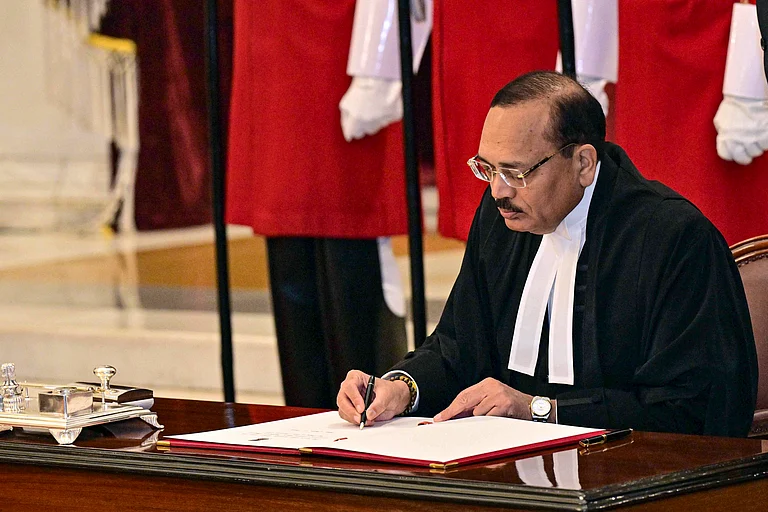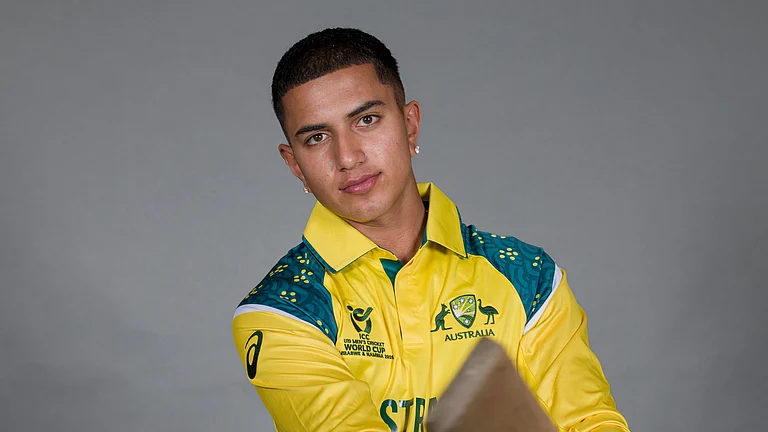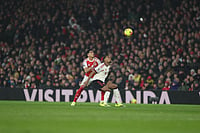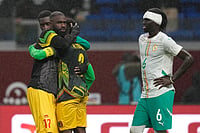Scenes of shattered glasses, an overturned table and a torn flex reading “Abdul Majid Meat shop” in Badshahpur, exposed rods, uncemented walls and green covers of the under-construction Anjuman Jama Masjid in Sector 57 chronicle the communal violence that gripped Nuh, Gurgaon and the nearby areas on July 31.
On August 1, the day after the Nuh violence, over a dozen police officials sit guard on chairs next to the boundary wall of the Badshahpur mosque. Rows of homes adjoining the wall, reportedly inhabited by Muslim families, are locked from the outside. In some homes, coolers and fans are still running; a clear indication that the families probably had no time to look into such nitty-gritty before fleeing from their homes.
The charred chassis of a motorcycle outside a temple as soon as one enters Nuh is the visual evidence of the violence that spread from Nuh to Gurgaon in a short span of time since July 31. Days later, fear and tension are still palpable in the air. Outside the Nalhar Medical College, where those injured on the day of the Nuh violence were admitted, a woman begged media personnel to get at least one 'dhaba' opened in the village as they had no food in their homes and the "imposed curfew" had starved their kids for three days.
Accounts of violence victims
On the morning of July 31, thousands gathered for the Brij Mandal Jalabhishek Yatra from Nalhar in Nuh. When the Yatra reached Khedla Mod, some people of the group allegedly raised slogans, which triggered stone-pelting and violence ensued.
By noon, clashes had spread all across Nuh and by evening, violent clashes were reported from areas adjoining Nuh, including Gurgaon. By night, slogans of “Jai Shree Ram,” also mentioned in the FIR filed by the police, terrorised different localities of Gurgaon, claiming one life, leaving another severely injured, and many others frightened for their lives. Many shops in Badshahpur were looted and burned in broad daylight and evening the following day.
The Anjuman Jama Masjid in Sector 57 was doused by a mob of hundreds at around 12:15 AM on August 1. Mohammad Shaad, the 22-year-old deputy Imam of the mosque, succumbed to multiple bullet injuries in his chest and abdomen. He had been designated just seven months back and was deputed by the senior Imam, who was away on the night of the violence.
Hailing from Sitamarhi, Bihar, Shaad’s final remains were taken by his 25-year-old brother, Shamshad, to his family on August 1. His mother was devastated. The village in Bihar echoed with demands for justice. “I did not get the post-mortem report. The police didn't tell me the exact cause of death. When we received the body, we could see six to seven gunshot wounds. His hands had cut marks in multiple places,” says Shamshad, adding that his wife and two children—two years and one month old—were still stuck in Delhi with his brother-in-law.
Forty-one-year-old Khurshid Alam, a father of six, was rushed to a nearby private hospital in Gurgaon and admitted to the ICU at around 1 AM on August 1. He had sustained multiple head injuries and a gunshot wound in his right knee. However, contrary to his medical reports, the police claimed it to be a ‘fracture’ and the administration refused to allow anyone to meet Alam.
A migrant labourer from Arariya, Bihar, Alam earned a livelihood by doing tile works. He’d sleep in the Masjid premise as his meagre income didn’t allow him to send money home to and rent a place to himself in Gurgaon. On the night of the attack on the Masjid, the mob found Alam along with Shad, thrashed him, and shot him in the knee.
Shauqat, Alam’s brother, was supervised by the police and hospital administration throughout his visit to the hospital. He reached the hospital at around 1:30 AM after his brother was admitted by those present at the site of the incident. “They did not allow me to carry my phone to him. His wife and our mother have been wailing since they found out about him, but we cannot have them here either,” shares the 28-year-old brother, who lives with his wife in Gurgaon and is a construction worker.
By August 2 night, Khurshid’s condition had improved after a blood transfusion and his family had been able to see him. “He couldn't say anything, but communicated in signs,” Shaukat says, adding that he had not gotten back to work since the day of the attacks.
The bone of contention
An FIR filed by the Gurgaon police names ten people from Tighra and Nathupur villages, along with 90-100 others, in relation to communal violence, mosque vandalism and attack on the police. The FIR also mentions the murder of Shaad and the attack on Khurshid.
Md Reyaz—the son of 78-year-old Shahbuddin, who was also present in the mosque at the time of the attack and was among the three who managed to hide inside an almirah—claims that the attack on the mosque was pre-planned and executed under the garb of the ongoing violence in Nuh. “The mob came sloganeering from Tighra village. They entered a greenish room where Imam sahab and Khurshid were asleep. They woke them up and then attacked them,” adds Reyaz.
The government-allotted land for the construction of the only mosque in New Gurgaon was long contended between the locals of Tighri and the Masjid Committee. In 2005, lands had been allotted for 17 temples, four gurudwaras, one church, and a mosque in the planned urban developed area in Gurugram. However, in 2007, the mosque received a stay order from the Ansal Plaza Group, Reyaz informs.
While the Masjid Committee won the case in the High Court, the case was subsequently appealed in the Supreme Court, where it was fought over the last 12.5 years, until three months back when, yet again, the Masjid Committee claimed victory.
However, despite the clearance, further construction has not yet recommenced awaiting revalidation from the government. “Ek mahina pehle dhamki di thi," maintains Reyaz. (We were threatened about a month ago). He cites a possible link between the agitated mob from the aftermath of the Nuh breakout and the Supreme Court hearing.
Outnumbered police
“It was the local public, there are no Hindus there (in Nuh), after all,” says a Gurgaon police official with a smirk when asked who was involved in the attacks, hinting at the involvement of Hindus in the mosque violence. The police and eyewitnesses have claimed that though police were present at the time of the attacks, however, they were heavily outnumbered.
There were only 10-12 police officials on duty at the time of the violence, when the attackers came on foot, having parked their vehicles at a distance. “Bas wo aaye, apna kaam kar ke chale gaye (they came, did what they had to and left),” says the official from the Gurgaon Sector 56 Police Station, where the FIR was registered. He claims that the SHO, Satish Kumar, was present at the time of the incident, however, Reyaz says that the police had to flee the scene as they were less in number and not fully equipped after the huge mob arrived at the scene.
On July 31, after tension gripped Gurgaon as news of the violence spread like wildfire by noon, shutters went down and eerie silence haunted the lanes of Badshahpur where shops allegedly owned by Muslims were targeted, looted and vandalised. As per the eyewitness account, 14 shops in the main market were besieged by men packed in SUVs and on motorcycles.
Eye witness account
Deepak Gaur, 28, who attended the Shobha Yatra at Nuh, described the communal violence in Badshahpur as a ‘reaction to an action.’
“Aisa laga jaise Pakistan me khade ho,” (We felt as if we were standing in Pakistan),” says the young ‘devotee’ whilst explaining the allegedly conspired episode that broke out at Nuh the previous day. According to Gaur, the rather customary ‘religious procession’ has been in place for the last few years and began with offering holy water at the Nalhar Temple and culminated at Punhana. This year as well, the yatra was ‘peaceful’, until it allegedly got disrupted by a mob of miscreants who started pelting stones, as the procession progressed. The disturbance soon turned into mayhem when two home guards got shot at near Khedla Mod. Soon, the episode turned on its head and led to violent clashes between the mob, the police, and the attendees, says Gaur.
At the Centre, government ministers and opposition leaders have appealed for peace in Nuh, and questioned the need for weapons during a religious procession. “All the guns were licensed. They were doing nothing illegal there and were carrying those weapons for their own safety and security reasons,” says Balwinder Jogi, a BJP karyakarta in Nuh, which is very close to the Nuh Police Station.
Politicians appeal for peace
When asked whether the BJP office was also attacked when the violence broke out, he says that it remained untouched, however, some shops nearby, allegedly owned by Hindus, were vandalised and the police station was attacked.
In Nagpur, on August 2, Bajrang Dal activists staged a protest against the communal clashes in Haryana and held Pakistan responsible for instigating the same, pronouncing Nuh as ‘Mini Pakistan.’ Vishwa Hindu Parishad leader Govind
Shende alleged that the annual Shobha Yatra was attacked by members of a minority community in Nuh. “This is the intelligence failure of the Haryana government,” Shende alleged.
Stray incidents of violence
The next day, on August 3, shops owned by Muslims continued to be targeted in Gurgaon and Badshahpur, allege the elders from the village of Ghasera in Nuh district. A Hindu man was allegedly beaten up by the mob at the sight of a board signalling Talique Halali meat shop,” the village elders add. “The shop was handed over to the Hindu man by Talique (23), who was earlier renting it and running his meat shop. He is the son of Md Amin from our village,” said 50-year-old Sarajuddin from the Meo village, also known as Gandhi Ashram. The same day, another mosque in Nuh was desecrated and apparently set ablaze by a short circuit, say police. This followed an attack on another Mosque on August 2, at 11:30 PM.
While one of the mosques was located near Vijay Chowk, the other was near a police station. Fire brigades were rushed to the two mosques and the fire was doused soon after, informing the police. “There are reports of light arson in one mosque while a short circuit seems to be the reason for the fire in the other. The police took control of the situation and are conducting raids to nab the suspects,” informs Varun Singla, the Superintendent of Police (Nuh). A senior police official assured that will try to identify the assailants with the help of CCTV cameras in nearby areas.
“Why did the police give permission for the procession?”
About 25,000 people participated in the procession to Nuh led by Vishwa Hindu Parishad, with other Hindutva organisations including Bajrang Dal, Gau Rakshak groups, and the RSS joining forces. However, a 'provocative' video by absconding “cow vigilante” Monu Manesar, went viral several days before the procession and caused a stir.
Muslim elders in the villages state that the provocative video of Manesar—accused of the murder of two, Nasir and Junaid, on the pretext of cow vigilantism—had caused a stir in the village. “There has been no violence during the previous processions. This time, the atmosphere was tense because of Manesar’s video,” villagers say, with others asking out why the police still gave permission for the huge procession.
Police and villagers have admitted that the local police present at the site of the violence were outnumbered to control the chaos and thus sought paramilitary forces’ help. Subsequently, as per media reports, 20 companies of central security forces were deployed in the state. When contacted, the SHO of Nuh, Inspector Kishan Kumar, was unavailable to meet. He refused to comment on the same when reached out to, on call.
Limping back to normalcy
In view of the violence, schools, colleges, and other institutes remained shut on August 2, while mobile internet services continue to remain suspended till August 5, in Nuh and other parts of Haryana. Besides Nuh, the services will remain snapped in Faridabad, Palwal, and the territorial jurisdiction of sub-division Sohna, Pataudi, and Manesar.
Meanwhile, section 144 was lifted off Nuh on August 3. “People can buy daily essentials from 10 am to 1 pm,” said Prashant Panwar, the Deputy Commissioner of Nuh. An SIT has been constituted to investigate the matter further.


























